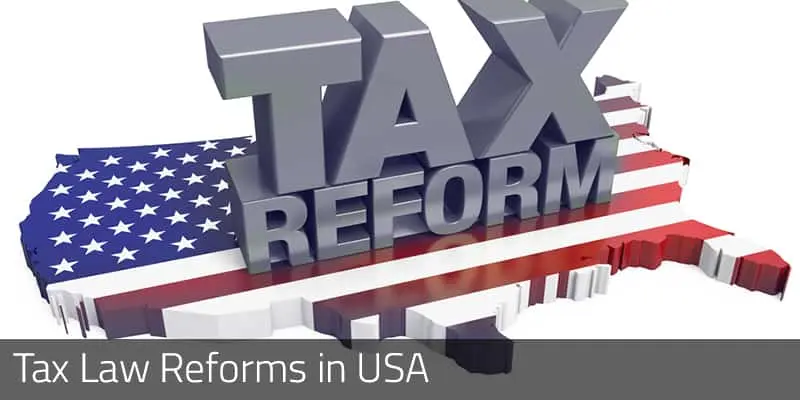
2021 Tax Law Reforms in USA
The Back ground
At the start of 2021, the world was still reeling under the impact of the ongoing pandemic. President Biden’s first priority was and continues to be to address the pandemic and its economic fallout. In addition to this, his campaign proposals for “Build Back Better” have significant impact on tax law and policy proposals that rely on higher taxes for US Corporations, high net worth individuals and foreign subsidiaries of US Corporations.
The economic impact of the pandemic on international trade relations, global supply chains, tax law, and revenue challenges of other countries also influence the tax law and policy proposals in USA. Of particular interest are the trade relations with China and post Brexit Europe.
International tax issues continue to be challenges for US multinational enterprises. More significantly, the debate and disputes over the digitalization of the global economy and the traditional concepts of permanent establishment and arm’s-length principles have intensified since 2015 when the OECD released its base erosion and profit shifting (BEPS) Action 1 report on ‘tax challenges arising from digitalization.’ The OECD in 2021 is seeking to complete work on proposals for significant changes to the overall global tax law framework as outlined in ‘Pillar One’ and ‘Pillar Two’ proposals.
In his inaugural address, President Biden pledged to action his campaign proposals to create better paying jobs, invest in American infrastructure, tackle climate change, address income inequalities, build on the Affordable Care Act (‘ACA’) by providing a Medicare option and make other modifications to Obamacare. The plans include-
- Increased funding for national vaccine distribution efforts
- Increased individual recovery direct payments
- Additional funding for state and local governments
- Support for small businesses to retain workers and avoid closures; and
- Expanded paid sick and family leave requirements
The Tax proposals
To pay for the various plans that are sought to be put into action, the key business tax law proposals include –
- US corporate tax rate to be increased to 28%,
- 15% minimum tax on the global income of companies
- The current minimum tax on profits earned by foreign subsidiaries of US firms to be doubled from 10.5% to 21%
- Sector-specific proposals for energy companies, real estate businesses, pharmaceutical companies, and large financial institutions
- ‘Make it in America’ tax measures to ‘end outsourcing’ and promote US domestic manufacturing and job creation
- Rules relating to the capitalization of research expenditures will take effect in 2022
- Rules to limit deductions for interest would also become effective in 2022
Key individual tax law proposals include-
- A roll-back of income and estate tax reductions from the 2017 tax reform act for those taxpayers with income greater than US $ 400,000. Some provisions of the 2017 tax reform act expire only at the end of 2025, while other changes are scheduled to take effect at earlier dates.
- For individuals with income greater than US $1 million, capital gains and dividend income to be treated as ordinary income
Some Details
1. Corporate rate increase to 28%
The 2017 Act set the corporate tax rate at 21% of net income. This is was a significant decrease in the rate from the corporate tax rate of 35% that had been in effect since 1993. Since 1993 many countries had reduced their corporate tax rates significantly making the combination of the US federal and state corporate rate the highest among OECD countries. The 2017 Act sought to make the US corporate tax more competitive globally.
A 28% federal corporate income tax would again make the US combined federal and state rate the highest among OECD countries. The average corporate tax rate for OECD countries, excluding the United States, is 23.4%.
2. Doubling the GILTI tax rate
The 2017 Act sought to tax global intangible low-taxed income (GILTI). The corporate tax rate set by the 2017 Act was 21%. A section 250 deduction of 50% was permitted, reducing the tax to 10.5%.
Under the present tax law proposals the corporate tax rate would be increased to 28%. In addition to this the Section 250 deduction would be reduced from 50% to 25%. The tax rate therefore becomes 21%, which is double that applied under the 2017 Act i.e. 10.5%.
In addition, he would change its application from an overall to a country-by-country calculation.
3. Minimum tax on book income
Companies with at least $100 million in book profits may be subject to an alternative minimum tax of 15% on its companies’ book income. Under an alternative minimum tax, a company would pay the greater of its regular tax or minimum tax liability. The tax law proposal provides a tax credit to companies for income taxes paid in foreign countries and allows companies to carry over book losses.
With the separate proposal for a 21% tax rate on GILTI, the greatest effect of the minimum tax on book income, may be on companies with a greater share of domestic rather than foreign income.
Differences between book income and tax income may be temporary (timing) or permanent differences. Temporary differences result in expenses being recognized sooner for tax purposes than for book purposes (e.g. with accelerated depreciation), or later for tax purposes than for book purposes, (e.g. bad debt expenses).
The details on how to compute the book and tax income would be specified.
4. ‘Make it in America’ proposals
Business tax law proposals to ‘end outsourcing’ and promote US domestic manufacturing and job creation include:
- A 10% surtax on the 28% corporate tax rate making the effective tax rate 30.8% on taxable profits. This applies to profits derived from any overseas production (or services) by a US company, for sales back to the United States
- A 10% tax credit on increase in wages above the company’s historic pre-Covid baseline. This applies to companies –
-
- making investments that will create jobs for American workers (includes revitalizing/retooling existing facilities and reshoring/ expanding job-creating production)
- for manufacturing jobs paying up to US $ 100,000
- Denial of deductions for moving jobs or production overseas
5. Capitalization of Research expenditure
Immediate expensing of research costs had been permitted since 1954. For tax years beginning after December 31, 2021, domestic research expenditures must be capitalized and amortized ratably over a five-year period. For research conducted outside of the United States the expenditure must the capitalized and amortized over a 15-year period. This is based on the theory that research provides economic benefits beyond the year in which the expense was incurred.
The down side of this proposal is that it will reduce the return to research activities and could result in less investment in research and experimentation.
6. Limits on Interest expense deduction
Under the 2017 Act, the deduction for net business interest expense is limited to 30% of the adjusted taxable income of the taxpayer. The adjusted taxable income is arrived at by adding back any deduction allowable for depreciation, amortization, or depletion. This is effectively the EBITDA of the company.
For tax years after December 31, 2021, the adjusted taxable income would not include the add-back for depreciation, amortization or depletion. In other word it would be the equivalent of the EBIT and not the EBITDA of the company. Therefore, beginning in 2022 the deductible interest will be determined on a smaller base, limiting the interest expense deduction. The cost of debt would therefore rise for US companies.
Companies with increased borrowings due the pandemic driven recession would be impacted.
7. Personal Income tax rates
The 2017 Act reduced the tax on personal income in excess of US $ 400,000 to 37% from 39.6%. It is now proposed to revert to the rate of 39.6%.
8. Personal Capital Gains taxes
An individual’s capital gains tax rate is based on their taxable income, with 20% being the maximum rate. The separate tax on net investment income increases the maximum rate to 23.8%.
It is now proposed to tax long-term capital gains and qualified dividends at ordinary tax rates for taxpayers whose adjusted gross income (AGI) exceeds US $1 million. In such cases, the treatment would be the same as for short-term capital gains and ordinary dividends, respectively.
It is also proposed that unrealized capital gains in excess of $100,000 (per individual) are taxed at death or upon gift, as opposed to waiting until the sale or exchange of the asset. Exceptions to this treatment would include passing the assets to the taxpayer’s spouse or charity.
In addition, the mark-to-market approach is proposed for capital gains to prevent the tax payers from deferring the payment of taxes to the point of sale of the asset. In other words, the capital assets are likely to be taxed on unrealized gains or losses annually. This proposal would apply to taxpayers with annual incomes above $1 million and/or ‘covered’ assets above $10 million.
Conclusion
The above are some of the proposals for reform of the tax law in the USA. They may or may not be popular but they are a necessity in these difficult time. The Balance of Power in the Senate would determine which tax law proposals will pass and which would need modification.
Disclaimer: This Article is for information only and readers are advised to seek professional advice before acting upon the information provided herein








